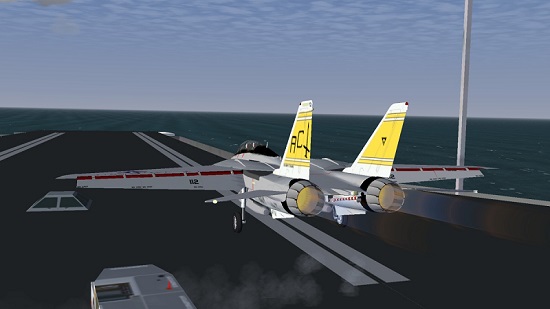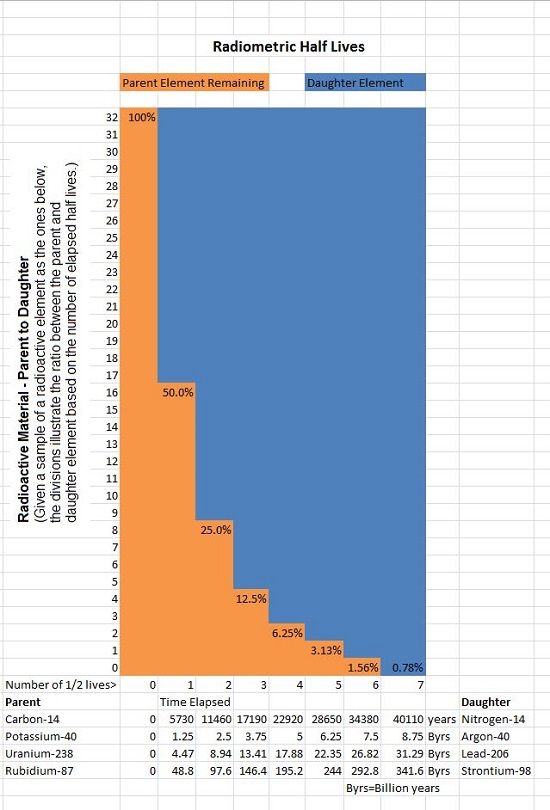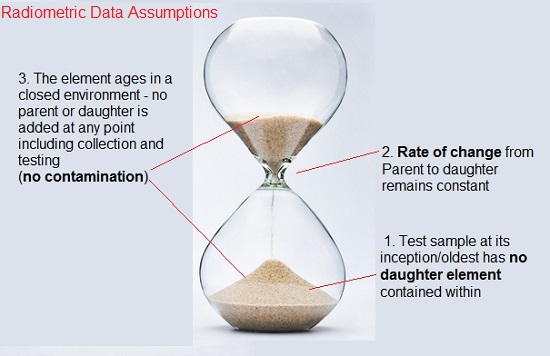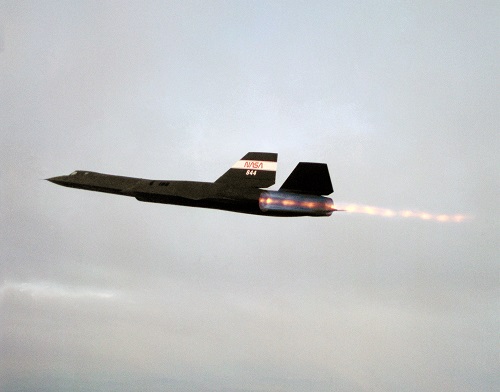
F14 in catapult with full afterburners
Is radiometric dating accurate? It’s science and many believe “science” to be synonymous with “always true” and therefore don’t question the data given, even when it contradicts the Bible – which also claims to be always true in information that it affirms. So when the two contradict – as they do with the age of the universe and the earth – many abandon the faith and reject the Genesis account because current science tells them that the universe and the earth is billions of years old, and disregard the biblical account – which indicates an age of about 6,000 years. The evidence many find persuasive: radiometric dating. But is radiometric dating really the objective hard science many believe it to be? By “objective, hard science” I mean science that is measurable, repeatable, predictable, consistent and accurate. For instance I would could consider the physics of flight a “hard science.” Here’s how those terms apply to the performance of an aircraft:
Measurable: Flight parameters such as take off and landing distance, fuel burn, etc. are all measurable.
Repeatable: Given the same initial conditions, those parameters should be the same regardless of who performs the operations.
Predictable: Since they’re repeatable, they’re also predictable. So aircraft designers and pilots can predict, given a certain set of circumstances precisely how much runway a plane will need to take off , and land; how much fuel will be burned, etc.
Consistent: Those parameters are consistent. Given the same conditions, the aircraft doesn’t need 2,000 feet of runway to take off one day, and 500 feet to take off the next day, and 3,000 feet another day.
Accurate: Performance predictions consistently fall within a narrow range of expected values and don’t vary greatly.
As a licensed pilot and certified flight instructor, I’ve bet my life, and the life of my students and passengers that I know exactly how a given plane will perform under given circumstances: how much runway it will take to take off, fly a specified distance and land at another airport. How it will react under various maneuvers. What inputs it takes to recover from a stall (that’s not a reference to the engine by the way) and spins. And I’m not the only one who’s made such a bet. Anyone who has flown in a plane is betting the science of flight is a “hard science” with consistent predictable results. On the other hand, would I bet my life on the supposed age of a rock, or fossil based on radiometric dating and the testimony of some PhD scientists? No, never; and I dare say neither would those same scientists because they know the limitations of the science. They know that radiometric dating is not, and in fact cannot be the precise science they want you to believe it is. Consider:
In conventional interpretation of K-Ar (Potassium-Argon) age it is common to discard ages which are substantially too high or too low compared with the rest of the group or with other available data such as the geological time scale. The discrepancies between the rejected and accepted data are arbitrarily attributed to excess or loss of argon.[1]
Radiometric Dating Indicates different ages by different methods
“Rejected and accepted data”? Why should there be rejected data? In other words scientists are saying they themselves will not accept some data from radiometric dating because they believe it to be wrong. Additionally they know that different methods of dating are providing different ages. That should not be. Consider stepping on a device to get your weight. You would expect your weight would be the same regardless of the method the device used to quantify your weight. So within a narrow tolerance of a few ounces or perhaps a pound or two, a spring scale should provide the same weight as a balance scale (like what you might see in physicians’ offices), which should provide the same result as an electronic scale. That there are different methods of determining weight is irrelevant to the fact that your weight is a single number, not a different number based on the method used. So if you in fact weigh 175 lbs, you would not expect one method to give you 50 lbs, another to give 250 and yet another to give you 388 lbs. If that is the case, it is indicative of a serious problem with the techniques you are using to get the weight.
Yet this is precisely the situation we have with radiometric dating. Radiometric dating regularly gives different ages for the same object based on the method used. For example check the variance in ages from samples tested by two different methods.[2] Variances were seen regardless of location:
| Rock Source | Dating Method | Age (Millions of Years) |
| Bear Mountain, WY | Potassium-Argon | 1,520 – 2,620 |
| Bear Mountain, WY | Samarium-Neodymium | 2,886 |
| Bass Rapid Sills, Grand Canyon, AZ |
Potassium-Argon | 841.5 |
| Bass Rapid Sills, Grand Canyon, AZ |
Samarium-Neodymium | 1,330 |
The expectation is that rocks located at the same site would date to the same age regardless of the method used. From the data above, obviously that is not the case. And the differences can be quite dramatic: Basalt – a type of volcanic rock – dated by K-Ar to 45 million years old, while unfossilized wood entombed in the basalt is dated to 45 thousand years old by Carbon14 dating.[3] Or the indisputable example of rock formed during the Mt Saint Helens eruption in 1980. We know the age of those rocks because humans were there to observe the formation. But when dated by the K-Ar method, did they get an age of a few years old? Not at all. The K-Ar method showed the age of the newly formed rocks as between 0.35 and 2.8 million years old.[4] Clearly incorrect. Does this make scientist reject the method? No of course not. Why this cavalier attitude toward the inaccuracy of all radiometric dating methods? Simply because they have a story to protect, namely that “the earth is billions of years old.” Because if the true age of the earth and universe were determined, the secular religious stories of evolution and the Big Bang would be demolished, having been clearly demonstrated to be false.
The Radiometric Dating Method
Once again let me point out that scientists regularly reject data from radiometric “dating” results. One expert admitted:
“If a C14 date supports our theories, we put it in the main text. If it does not entirely contradict them, we put it in a footnote. And if it is completely ‘out of date’, we just drop it.”[5]
Or consider the statement of an evolutionist who didn’t agree with the radiometric dating (using five different radiometric techniques) of Australia’s “Mungo Man”, thinking it placed humans in Australia too early. He stated:
“For this complex laboratory-based dating to be successful, the data must be compatible with the external field evidence.”[6]
So here’s another evolutionist who refused to accept the results given from radiometric dating. Why is there so little confidence in the outcome of radiometric dating that scientist admit that they regularly reject data provided by that means? All you need to do is compare the methodology of radiometric dating with that of predicting aircraft performance and the answer becomes perfectly obvious. In fact you may have already noticed a number of dead give aways in the above description of the hard science parameter specifications of aircraft performance above. Those give aways are words like:
- Initial conditions
- Certain set of circumstances
- Given the same conditions
Precisely quantifying aircraft performance is all about knowing conditions and circumstances. For take off, a pilot needs to know things like: wind direction and speed, runway direction and length, aircraft weight, air temperature and altitude above sea level, runway condition (wet, dry, snow covered, etc.). Given all the needed factors (and pilots are required to know them and plan for them before every flight) a pilot can accurately predict the performance of his aircraft so he can determine whether he can safely take off and conduct the flight. But radiometric dating allows no such certainty. In fact it’s full of guess work. And as noted above, those guess have been shown to be consistently wrong.
The Science and Guesswork of Radiometric Dating
The science
Age is not a quantity that can be directly measured. So scientists aren’t actually measuring age with any technique they use. Since they can’t measure age, what they do instead is look for something that varies regularly with the passage of time, that leaves a permanent record and then use that property to correlate the passage of time. Radioactive decay occurs (usually) at a regular rate, so scientists attempt to use that property as a clock to mark time. Here’s how the method is supposed to work:
Looking at carbon in the periodic table we see this:

“6” is the atomic number and means it has 6 protons. All carbon atoms have 6 protons. The atomic mass (rounded) is 12. The mass is comprised of the protons and Neutrons (electrons are so light they are can typically be ignored.) This means it has 6 protons and 6 neutrons. A carbon “isotope” is formed when the number of neutrons vary from what is expected from the atomic weight. For example, two isotopes of Carbon are Carbon-13 and Carbon-14 with 7 and 8 neutrons respectively instead of 6. Like Carbon-12, Carbon-13 is stable. But Carbon-14 is unstable and will eventually “decay” by having a neutron converted into a proton in a process called beta-decay which leaves the carbon atom with 7 protons and 7 neutrons which – as you can see above – is a Nitrogen atom. So Carbon-14 decays into Nitrogen-14. This process happens at a standard rate – which is measured by half lives.
A half life is the time it takes 1/2 the parent element of a radioactive material (in the above example Carbon-14) to decay to the daughter element (Nitrogen-14). The rate of that transformation is constant, and for Carbon it takes about 5,730 years. So as the below chart shows. after the first 1/2 life of 5,730 years, half the Carbon-14 is gone, having been converted to Nitrogen-14. After the 2nd half life, 11,460 years have elapsed and another 1/2 of what remained is gone leaving 1/4 of the original Carbon-14 and so on. This process is essentially the same with other materials used for radiometric dating, with the primary thing of interest that changes is the length of the 1/2 life as illustrated below.

You’ll note that the half life of carbon-14 – about 5,730 years – is relatively short compared to other elements like Potassium and Uranium which have half lives in the billions of years. Thus Carbon-14 dating cannot be used to date things over 80-100,000 years old because at that point there is too little Carbon-14 left to accurately detect. Thus if an item is claimed to be more than 100,000 years old, there should be no detectable Carbon-14 – it should have all decayed away. That’s why diamonds are such a problem for believers in radiometric dating. Diamonds are supposed to be among the oldest rocks on earth, formed in the bowels[7] of the earth and dating back 2-3 billion years. If they were truly that old there should be no Carbon-14 in them, but surprise, as the RATE group[8] demonstrated, the amount of Carbon-14 in diamonds is well above the detection limit. This means that the age of such diamonds must be under 100,000 years – otherwise the Carbon-14 would be undetectable. This is strong evidence that the earth is not the 4.5 billion years it is claimed to be. That’s just a symptom of the main problem with radiometric dating. The main problem is all the guesswork involved in an attempt to determine age.
The guesswork
So above we see process which scientists believe they can use as a gauge to accurately measure the passage the time. But what are they really measuring? With their high precision Mass Spectrometers, all they can measure is the amount of parent and daughter element in any given sample. What does that tell them? It tells them the ratio of parent and daughter element in a particular sample. It says nothing about age. Because as noted above – age is not a quantity you can directly measure. So how does a measurement – primarily of the daughter element – get transformed into an age? They use the ratios they’ve measured to make guesses about age, based on assumptions. These assumptions are guesses about what we talked about above: initial conditions and the accompanying circumstances. So in order to “determine” a date, having measured the amount of daughter element in a sample, the scientists must assume or guess that:
1. The original amount of the daughter element in the tested item is zero, and the original amount of the parent element can be ascertained.
2. The rate of change of Parent element to daughter element is constant.
3. The system is closed; no additions to parent or daughter element occurs throughout the duration of the alleged age of the sample, and particularly during collection and testing. (When additions are made during collection or testing, this is commonly referred to as contamination.)
These problems are typically illustrated with an hour glass as follows. Keep in mind all a scientist can measure is the amount of parent and daughter element in the sample. The amount of the daughter element (represented by the sand in the bottom of the hour glass) becomes a key to the age. The more they find, the older they assume the tested item to be. This is in spite of the fact that they have no “control sample” from the time period in question to tell them what the ratio should be – they make guesses at what it should be.

So based on this assumption-ridden process, we’re told that the earth and the universe can’t be thousands of years old because radiometric dating proves that the earth must be billions of years old. (And according to the Big Bang – the universe is older than the earth.) Yet we’re never told how they propose to overcome the errors introduced by the assumptions.
If the same assumptions were applied to aviation, particularly military aircraft you could easily see how foolish the person making the statement would appear. For example, consider a take off or landing under standard conditions. Such operations normally require about 4 thousand feet of runway for fighter jets. (A bit less for landing.) If you had only a thousand feet, could you take off or land? Assuming “standard conditions” one could only come to the conclusion that take off and landings are impossible from aircraft carriers – since their runways are a fraction of the required distance.(A thousand feet or less.) But that obviously assumes no other initial condition helps are available – like catapults (in the featured picture above) and arresting wires (below).

F-18 landing with an arresting wire aboard a US aircraft carrier
Or one could assume that given the limited fuel tanks on fighters, certain long distance missions are impossible. That of course assumes that external factors like in-flight refueling are impossible.

F-18 Super Hornet refuels in flight from KC-135 supertanker
Or a flight engineer could calculate the aircraft has plenty of fuel to reach its destination on a routine flight, yet the plane is unable to and calls for refueling or must land for fuel because the plane is low on fuel. Why? Because the pilot flew the entire flight with the after burners on and the rate of fuel burn was significantly higher with after burners on than in standard cruise power.

The SR-71 Blackbird with full afterburners on
These hypotheticals parallel the problems of radiometric dating depicted in the hour glass picture. Clearly in all these cases, the performance that was thought impossible or unexpected was based on assumptions – not fact. In aviation, such assumptions could get you killed. Believing the evolutionary assumptions – like the false dates based on radiometric guesses could lead to spiritual death if belief in an old earth causes you to disbelieve God.
A Final note on Contamination and Rates
Before closing this topic I want to point out two facts that proponents of radiometric dating would prefer you not know. First, the effect of contamination – where the daughter element is added. If you look at the chart above you’ll note that any addition of the daughter element – moves you further down the blue shaded area – indicating greater age – and depending on the type of radiometric dating even a small amount of contaminate could lead to the conclusion the sample is thousands, millions or even billions of years older than it really is.
Interestingly, when evolutionists get a date they like, they have no problem with the process, but as soon as the date is out of spec, they reject the data, talking about contaminated specimens. And hypocritically, only they are allowed to cite that error. (Or if you prefer, they regularly engage in the error of special pleading to excuse clearly erroneous findings.) But as soon as a creationist doubts the date and cites the same problem, it’s because we’re “unscientific” or “don’t understand the science,” or are “science deniers.” Hogwash. the problem is radiometric dating is full of guesswork and errors, and long age believers simply don’t want to acknowledge that.
The second item of note is the assumption on rates. Evidence is coming in from a number of sources that radioactive decay not occur in the standard, linear, non-changing manor that they’ve thought for all these years.
“Recently some scientists in the US and Europe determined that the transformation rate of at least some elements, notably Cobalt-60, Caesium-137, Silicon-32 and Radium-226 – do indeed vary with time. Now they don’t know why this is, but they have noted that the rate varies with the distance between the earth and the sun.”[9]
Jim Mason
In other words assumption 2 – that the rate of change is constant – is false.[10] Thus not even the highly vaunted consistency of radioactive decay performs as claims. Additionally with regard to Carbon-14 dating – those dates will be off because of another set of assumptions: these have to do with the Earth’s magnetic field. Since scientists believe the earth to be 4.5 billion years old they propose a “dynamo” – a natural generator – to sustain the field, otherwise the field would have died out long ago. But as I note here the earth’s magnetic field has been steadily decreasing. This not only supports the young earth position that the magnetic field was setup a mere few thousand years ago when the earth was created; but it also means that the magnetic field would have been stronger in earlier days than it is today. That has a significance for Carbon-14 dating as follows.
Carbon-14 is produced on an on-going basis by cosmic rays in the form of high energy protons which in effect run the above decay process in reverse. They collide with Nitrogen-14 atoms and convert them to Carbon-14 atoms. Those carbon-14 atoms are ingested by plants, and the plants are eaten by animals which is how carbon-14 gets into animals and thus fossils. The point here being, if the magnetic field was stronger a few thousand years ago than it is now, fewer cosmic rays would get through, producing less Carbon-14. This would change the above mentioned ratio, and make samples look older than they would under current conditions.
Conclusion
Since age is not a quantity that can be measured, the only reliable way to determine age is by having a historical record – which is what the Bible provides. All the dating techniques in the world cannot “prove” the age of the earth or the universe or anything else. This is because they are all based on assumptions that cannot be proved. Scientists cannot go back in time and observe the initial conditions to determine if the assumptions are correct. Thus they have no clue as to the accuracy of their dating methods because their comparison checks – like the geological column – are also based on assumptions, not observation.
The one thing that can be concluded however from radiometric dating is this: Based on fact that Carbon-14 is detectable in diamonds, the earth cannot be billions of years old. The earth’s decreasing magnetic field is a fact that corroborates this since it could not have been decreasing for billions of years. Thus the better interpretation of the evidence is the earth is not billions of years old, but merely thousands as the Bible implies. Even more importantly, we see the Bible has been correct all along: In the beginning, God created the heavens and the earth.
Duane Caldwell | posted 10/31/2016 | printer friendly version
Follow @duanecaldwell
Related Articles:
Diamonds: A Girl’s and a creationist’s best friend
Earth’s Magnetic Field: Testament to more than a Young Earth
Notes
1. Akio Hayatsu (Department of Geophysics at the University of Western Ontario), K-Ar isochron age of the Northern Mountain Basalt, Nova Scotia, Canadian Journal of Earth Sciences 16:974, 19479 ref from Evolutionists Say the Oddest Things, Lita Cosner, Compiling Editor, Powder Springs GA: Creation Book Publishers, 2015, p. 94
Back
2. Bear Mountain Data: S.A. Austin, “Do radioisotope clocks need repair? Testing assumptions of isochron dating using K-AR, Rb-Sr, ,Sm-Nd and Pb-Pb isotopes”, in Vardiman et. al. Radioisotopes and the Age of the Earth pp. 325-392, 2005; D. DeYoung, Thousands…Not Billions, pp.109-121,2005, ref from Mike Riddle “Does Radiometric Dating Prove The Earth is Old?” in The New Answers Book, Ken Ham Gen Editor, Green Forest AR: Master Books, 2006, p. 120
Grand Canyon Data: A.A. Snelling, S.A. Austin, and W.A. Hoesch, “Radioisotopes in the diabase sill (Upper Precambrian) at Bass Rapids, Grand Canyon, Arizona: an application and test of the isochron dating methods”, in RlL. Ivey, Jr. (ed.), Proceedings of the Fifth International Conference on Creationism, Creation Science Fellowship, Pittsburgh, Pennsylvania, pp. 269-284, 203; S.A. Austin, in Vardiman et al. 2005, 325-392 D.DeYoung, 2005, 109-121 ref . from Mike Riddle, The New Answers Book, p. 121
Back
3. Evolution’s Achilles’ Heels, Documentary, Creation Ministries International (CMI), 2014
Back
4. Austin, S.A, 1996: CEN Tech J.10(3):335-343
ref from A Brief But True History of Time, Mark Harmon, CMI DVD, 2009
Back
5. Quoted by Säve-Söderberg., T. and Olsson, I.U. (Institute of Egyptology and Institute of Physics respectively, University of Uppsala, Sweden), “C14 dating and Egyptian chronology”; in Olsson, I.U.,(ed.) Radiocarbon Variations and Absolute Chronology, the 12th Nobel Symposium, p.35 John Wiley & Sons, Inc., New York, 1970, ref from Jonathan Sarfati The Greatest Hoax on Earth? Refuting Dawkins on Evolution, Atlanta Georgia: Creation Book publishers, 2010, p.194
Back
6. Bowler, J.M. and Magee. J.W., Redating Australia’s Oldest Human Remains: A Skeptic’s View, Journal of Human Evolution 38, 719-726, 2000. ref from The Age of the Earth, Tas Walker CMI DVD, 2007
Back
7. “Shirey adds that diamonds are also special because they’re the deepest minerals we can obtain as natural samples to study the earth. Unlike any other mineral, diamonds reach the surface from great depths—up to 700 kilometers (435 miles) beneath the earth’s surface”
Tiny Inclusions Reveal Diamond Age and Earth’s History: Research at the Carnegie Institution, Duncan Pay, Jim Shigley, Pedro Padua 1/31/2014,
http://www.gia.edu/gia-news-research-tiny-inclusions-reveal-diamond-age
Back
8. RATE – Radio Isotopes and the Age of the Earth, project name adopted by a group of scientists who support creation who did a scientific study of radiometric dating to determine its validity. Sponsored by ICR, results are summarized in the Book and Video Thousands…Not Billions
Back
9 Jim Mason, ref from Evolution’s Achilles’ Heels, CMI Documentary, 2014
Back
10. A strong case for a radically increased rate of change of radioactive decay in the recent past is made in Thousands…Not Billions
Back
Images:
Featured Image: F14 locked in catapult by Mhab | CCA
Radiometric Half Lives © Duane Caldwell
Radiometric Data Assumptions – hourglass © pogonici | fotolia
F18 Landing with arresting wire: US Gov | Public Domain
F-18 Super Hornet in-flight refueling: US Navy | Public Domain
SR-71 Blackbird with full afterburners: NASA | Public Domain

